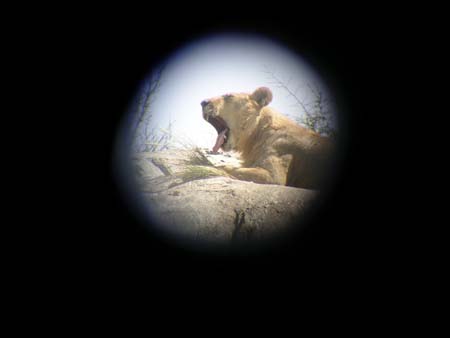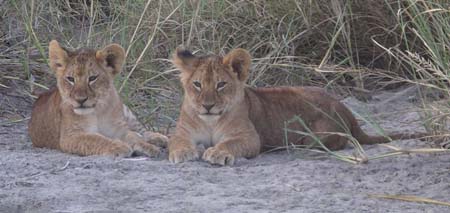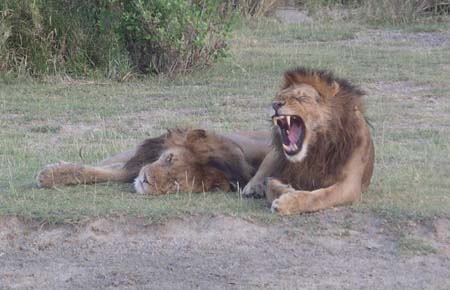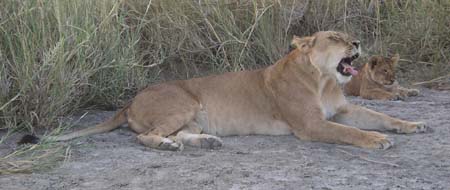Wednesday, May 26
Paula and Steve: We were all a bit sad upon leaving our
lovely and comfortable campsite this morning. We have spent three days here
soaking up the wildlife by day and the wonderful hospitality of the camp staff
by night. But after another striking sunrise and delicious breakfast, we headed
south through  the
Serengeti Park one final time on our way to the Ndutu Safari Lodge. This lodge
is situated between The Serengeti and Ngorongoro Crater where we will head
tomorrow, so it provides an excellent stopping point.
the
Serengeti Park one final time on our way to the Ndutu Safari Lodge. This lodge
is situated between The Serengeti and Ngorongoro Crater where we will head
tomorrow, so it provides an excellent stopping point.



In our final drive through the Serengeti, we enjoyed viewing the now familiar wildlife along the road, including baboon, impala, hyena (including the one pictured here right by the road), hippo, giraffe, ostrich and topi. As we approached the southern half of the park, we again began seeing herds of wildebeests and zebras heading toward Lake Magadi. This was where we had seen so many of the migrating animals yesterday and we are certain the lake is a busy place again today.
As we continued south, we began seeing kopjes and Nassibu watched closely for any signs of lions. Suddenly, we spotted a beautiful female sitting on a small ridge overlooking the valley. We admired her and wondered whether she was hunting or just surveying her pride. Eventually, she settled in the grass to rest and we left her to nap.
 Just
ahead were the Simba Kopjes and here were we found three lions sunning high
on the rocks. A young male (about 18 months old) entertained us by yawning,
standing up and stretching before turning around and reclining again in a
different position. A three month old female cub also sat close by and even
walked down the rocks to a stream to drink. Her face and oversized paws were
very cute.
Just
ahead were the Simba Kopjes and here were we found three lions sunning high
on the rocks. A young male (about 18 months old) entertained us by yawning,
standing up and stretching before turning around and reclining again in a
different position. A three month old female cub also sat close by and even
walked down the rocks to a stream to drink. Her face and oversized paws were
very cute.  Watching
over these young lions was a mature female resting high on the outcropping.
She paid little attention to us and eventually headed down into some trees
for the shade. We marveled at how these wild lions still have the same mannerisms
as our own housecats.
Watching
over these young lions was a mature female resting high on the outcropping.
She paid little attention to us and eventually headed down into some trees
for the shade. We marveled at how these wild lions still have the same mannerisms
as our own housecats. 
As we left the Serengeti Park through the Naabi Hill Gate, we stopped at
the visitor center for one last view of the beautiful plains. It was here
that we also got our first view of the agama lizard. This lizard has a red
head and blue body which it uses to attract mates. It was also on the roadside
before and just after  Naabi
Hill that we saw several spotted hyenas. We got very close to one who appeared
to be watching the nearby den. They were more attractive than we expected
and also quite large. We learned that they sometimes chase cheetahs and even
lions away from their kills.
Naabi
Hill that we saw several spotted hyenas. We got very close to one who appeared
to be watching the nearby den. They were more attractive than we expected
and also quite large. We learned that they sometimes chase cheetahs and even
lions away from their kills. 
Beyond the Naabi Hill Gate, the tall grass disappeared from the plains. Nassibu explained that this area is the home of the wildebeests from November to May, and that they eat the tops of the grass before they migrate north. After the wildebeests cut the grass down to shorter shoots, the gazelles and other grazers move in to eat lower grasses that they love. Today we saw hundreds of gazelles and spotted our first Thomsons gazelle as well as elands which are the biggest antelope in the Serengeti.
 We
reached the Ndutu Lodge in time for lunch. The lodge is surrounded by wildlife
and sits among acacia trees overlooking Lake Ndutu. After a couple of hours
to rest and read, we were
We
reached the Ndutu Lodge in time for lunch. The lodge is surrounded by wildlife
and sits among acacia trees overlooking Lake Ndutu. After a couple of hours
to rest and read, we were  ready
to set out for a late-afternoon drive to explore Lake Ndutu and the surrounding
area. This was one of the prettiest drives we have done, initially winding
our way through forested hills and then along a river that actually eventually
becomes the Oldupai Gorge. Nassibu told us to look in the shade of the acacia
tr
ready
to set out for a late-afternoon drive to explore Lake Ndutu and the surrounding
area. This was one of the prettiest drives we have done, initially winding
our way through forested hills and then along a river that actually eventually
becomes the Oldupai Gorge. Nassibu told us to look in the shade of the acacia
tr ees
for lions that may be resting after a long day in the sun. The tall grasses
were probably hiding a variety of animals, because other than a few zebras
hanging out in an open area, we didn't see much wildlife at first.
ees
for lions that may be resting after a long day in the sun. The tall grasses
were probably hiding a variety of animals, because other than a few zebras
hanging out in an open area, we didn't see much wildlife at first.
We climbed a hill and had a great view looking back to Lake Ndutu. Even from a distance we could see the distinctive color of the pink flamingoes that congregate here, and Nassibu told us that we'd be seeing many more of these birds in the Ngorongoro Crater.
We then approached the river that looked to be mostly dry with wide banks,
an area that looked perfect for wildlife. The far side of the bank  was
heavily forested and we could see several giraffes and impalas in the distance.
However, our primary objective was to spot the predators, specifically lions
and cheetahs, which often wait here for unsuspecting prey coming for afternoon
drinks. We drove slowly along the river for probably an hour, but we saw surprisingly
very little. Sightings included some hartebeest (pictured on the right), a
jackal (a new animal for our list), a pair of impressive secretary birds (one
is pictured above), a bat-eared fox and the ubiquitous impala, but no predators.
was
heavily forested and we could see several giraffes and impalas in the distance.
However, our primary objective was to spot the predators, specifically lions
and cheetahs, which often wait here for unsuspecting prey coming for afternoon
drinks. We drove slowly along the river for probably an hour, but we saw surprisingly
very little. Sightings included some hartebeest (pictured on the right), a
jackal (a new animal for our list), a pair of impressive secretary birds (one
is pictured above), a bat-eared fox and the ubiquitous impala, but no predators.
We have learned quickly to totally trust Nassibu and his instincts, and as
he drove it seemed that even after our two hours of sparse sightings he was
confident that we would find something special. Nearing the end of our drive,
we approached the smaller Lake Masek where Nassibu said something to the effect
of, "boy, that would be a perfect area for lions to hang out and sun
themselves at the end of a day." We scanned the area, but nothing seemed
to  be
there. Driving slowly, we carefully checked out the tall grasses beside the
road, looking for a splash of orange that would indicate a hiding lion. Still
we saw nothing. We then rounded a corner, and then Nassibu spotted what we
had looking for all afternoon - a large male lion, sitting precisely in the
grassy area that Nassibu had suggested that lions would be likely to frequent.
Looking through our binoculars, we could tell that he was full-grown with
a beautiful mane, and we excitedly began driving toward him.
be
there. Driving slowly, we carefully checked out the tall grasses beside the
road, looking for a splash of orange that would indicate a hiding lion. Still
we saw nothing. We then rounded a corner, and then Nassibu spotted what we
had looking for all afternoon - a large male lion, sitting precisely in the
grassy area that Nassibu had suggested that lions would be likely to frequent.
Looking through our binoculars, we could tell that he was full-grown with
a beautiful mane, and we excitedly began driving toward him.
Lions are not solitary animals, and not surprisingly we found another male
along with a female lion right along the road. We were already very excited,
but became absolutely thrilled when we saw that this couple was accompanied
by two small lion cubs, both less than 3 months old. The cubs were wrestling
together and playing with their mother, and the three lions let us approach
with the Land Rover until we were parked directly beside them. This was an
absolutely unbelievable sight. There we were, in the beauty of the late afternoon
sun, all alone with this family of lions that was carrying on without seeming
to even noti ce
our presence. The cubs were the most entertaining as they took turns jumping
on their mother and playing among themselves.
ce
our presence. The cubs were the most entertaining as they took turns jumping
on their mother and playing among themselves.
Eventually, the mother and her cubs got up to walk closer to the lake, and the male did the same. We then watched as the male approached the original male that we had spotted sunning himself, and Nassibu told us to expect the two brothers to execute the standard "lion greeting" which includes a rubbing of noses and faces. The lions did in fact do this greeting, and then sprawled out together in the grass. Meanwhile, mom was watching the cubs as they played in a stream by the lake. As we observed them romping and attacking each other, we were struck by how similar their mannerisms were to those of domestic kittens. All cats behave the same.







We watched for close to an hour when Nassibu pointed out a lone zebra across a large field. Nassibu told us that this zebra was probably in danger, and sure enough we watched as the female lion also became aware of the zebra, told her cubs to stay put, and began stalking her prey (as we have learned, the females do almost all of the hunting for their prides - the males are known as being lazy). To reach the zebra, she had to circle around the field, using various bushes and grass patches for cover. We were all cheering her on, hoping for the opportunity to witness a "kill." We observed the lion through our binoculars as she stalked and slowly made her way toward the zebra.
Unfortunately, all vehicles must be out of the national parks by 7:00PM, so we were unable to stay to see what happened. Most likely, the lion wasn't going to attack until after dark, taking advantage of her keen eyesight (and the zebra's inability to see well in the dark). In any case, more than 75% of all lion hunts end up in failure, so maybe the zebra survived after all. Simply seeing the lion and her hunting behaviors was wonderful.







At dinner this evening, we were able to observe a genet, a nocturnal cat that's a common carnivore as it sat and paced in the rafters of the dining room at the N'Dutu Lodge. We also were amused by the large bats that repeatedly flew in to catch the bugs that were attracted by the lights. After capturing their prey, the bats would hang upside down from the lamps over our heads.
This was another great day, and our encounter with the pride of lions is something we'll never forget. Tomorrow we are headed to the N'Gorongoro Crater which we know is a special place that is very famous for its spectacular wildlife.

David's Daily Dump: Lions. One of the more magnificent animals that we have seen and been able to observe on our safari through the Serengeti has been the lion. In all, we have seen 12 of these kings of beasts, including cubs, full grown males, and adult females. The first male we saw resting by a stream in the shade left us in awe. His incredible mane and massive body was overwhelming. We thought that he was quite cute and gentle looking, until we yawned and showed off his teeth. We also noticed vultures near by, and guessed that he had eaten just before we arrived.
We found another lion (a female) lying up in a tree (which is rare) trying
to get away from the oppressive flies. She was with another member of her
pride (family or group), who was right by the road and sat by a wildebeest
horn. She had been following the migration. Another four we spotted were all
members of the same pride and up on a kopje (rock formation) soaking up the
sun. Among them was a juvenile male with only half a mane, and a cute three-month
old with paws too big for him. 
Perhaps the most amazing encounter we had with lions was when we came across
a small family, with a couple of two month old cubs. We found them in a grassy
area near a lake, spending some quality family time together. First we spotted
the huge male, then the protective female and her two tiny cubs. Luckily,
we were able to get really close to them without disturbing them. They were
spectacular!! It's so amazing to see these creatures in the wild and in their
natural state. We especially enjoyed watching the cubs wrestle with each other
and pounce on their mother. They kept on staring at us curiously while the
female kept a watchful eye on us. Occasionally, the female would get up, stretch,
and walk into the tall grasses. If the cubs did not follow, she would make
a low growling sound, and they would immediately stop what they were doing
to find her. She seemed like she was looking for other members of her pride
to help her hunt later. 
After we filled up several disks with photos, the male woke up and moved off toward the lake. The female followed behind, and made sure her playful cubs kept up. We soon realized that the male was headed toward another lonely male in the distance and we guessed that they were brothers. Nassibu told us that they would have a greeting ceremony, so we followed close behind. When the males finally reached each other, they rubbed their heads together affectionately, and plopped down in the grass for a nap, while the female and cubs went to drink and play by a pond. As we watched the lions and cubs, we found that they did a lot of the same things that our cats do. They rested in some of the same positions, and even played with each other the same way. We always joked about how our big yellow cat looked like a lion, and now we realize that he really does!
As we admired the pride, we noticed a solitary zebra grazing in the distance
by the water. Nassibu guessed that the lions would try to make him their dinner,
and he was correct. Eventually we noticed the female looking at the zebra,
and she immediately walked out into the open to get a better l ook.
She then walked over to the cubs seemed to tell them not to follow her. They
did as they were told, and she took the long route around the plain through
the bushes, while keeping a look out for any other members of the pride that
would help her. The hungry males looked on and did nothing to help. Usually
other females would have helped, but we did not see any others. We followed
the female through the tall grasses excitedly, at the thought that we could
see a kill! After a while, one of the males walked into the plain and sat
down ready to eat if there was a kill, while the other one watched the cubs.
Nassibu told us that they would not attack until night, and it turned out
that he was right again. We watched until it was tough to see the jeep, and
lost the female in the dark. We decided to get up early the next morning to
see if the hunt was successful. We didn't see any bones or lions, and assumed
that the zebra was able to live another day.
ook.
She then walked over to the cubs seemed to tell them not to follow her. They
did as they were told, and she took the long route around the plain through
the bushes, while keeping a look out for any other members of the pride that
would help her. The hungry males looked on and did nothing to help. Usually
other females would have helped, but we did not see any others. We followed
the female through the tall grasses excitedly, at the thought that we could
see a kill! After a while, one of the males walked into the plain and sat
down ready to eat if there was a kill, while the other one watched the cubs.
Nassibu told us that they would not attack until night, and it turned out
that he was right again. We watched until it was tough to see the jeep, and
lost the female in the dark. We decided to get up early the next morning to
see if the hunt was successful. We didn't see any bones or lions, and assumed
that the zebra was able to live another day.
Seeing all the wildlife in this amazing country has been great. This is defiantly something that should not be missed in a lifetime. It's one thing to see lions, giraffes, and elephants in zoos, but to see them in the wild is totally different. I think that this will be one of my favorite things of the whole trip…
Animals seen today:
Baboon (a large troop of 60-70)
Giraffe
Impala
Grants gazelle
Hippo
Ostrich
Hyenas
Topi
Zebra
Wildebeest
Lion
Agama Lizard
Cape Eland
Thomsons gazelle
NEW birds sighted:
Green Backed Heron
Kori Bustard
Newben Vulture (largest in Tanzania)
